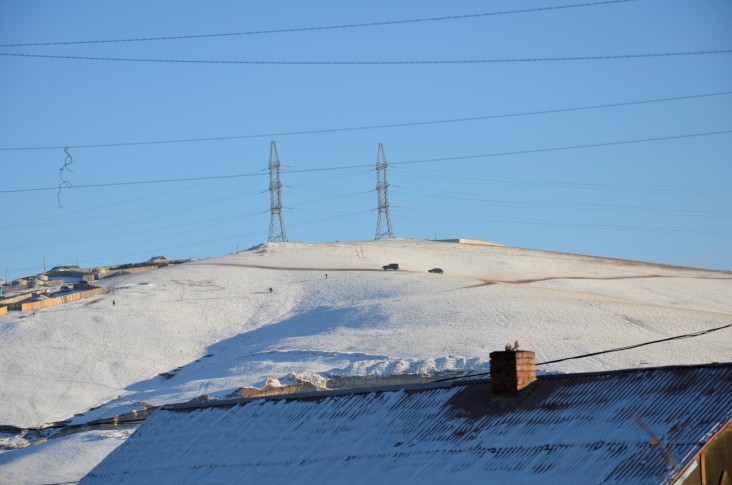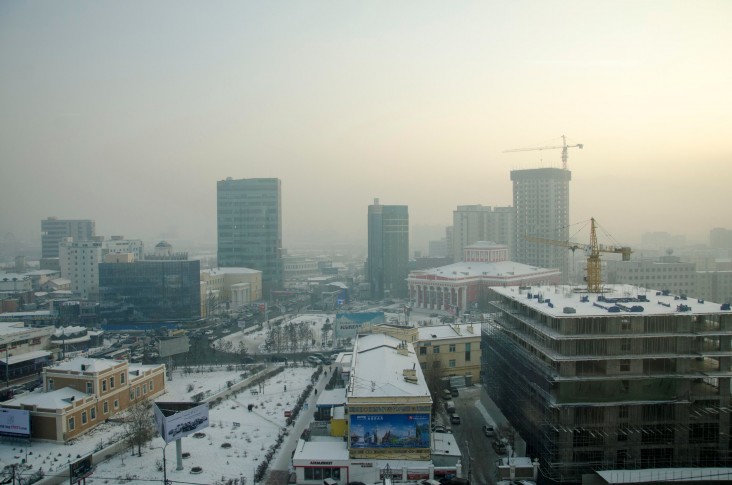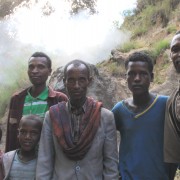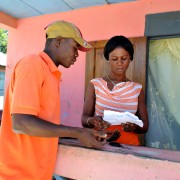 Urantogs Chimiddorj holds a signed supply contract with Ulaanbaatar Electricity Distribution Network Authority for her company’s new cement plant in Ulaanbaatar, Mongolia.
Tsolmon Naidandorj, BPI
Urantogs Chimiddorj holds a signed supply contract with Ulaanbaatar Electricity Distribution Network Authority for her company’s new cement plant in Ulaanbaatar, Mongolia.
Tsolmon Naidandorj, BPI
 Urantogs Chimiddorj holds a signed supply contract with Ulaanbaatar Electricity Distribution Network Authority for her company’s new cement plant in Ulaanbaatar, Mongolia.
Tsolmon Naidandorj, BPI
Urantogs Chimiddorj holds a signed supply contract with Ulaanbaatar Electricity Distribution Network Authority for her company’s new cement plant in Ulaanbaatar, Mongolia.
Tsolmon Naidandorj, BPI
In 2009, Urantogs Chimiddorj, a young manager at a holding company with construction, cement and felt processing activities, was under pressure. Her task was to open a felt manufacturing unit in the isolated Ulziit district of Ulaanbaatar before the long, harsh Mongolian winter halted construction, leaving the famed blue skyline littered with unfinished buildings. The first in her family to finish college and a novelty as a female manager for the holding group, she had high hopes of completing the assignment and taking her employer, XMG LLC, to the next level.
Chimiddorj had done everything right. She was ready. She negotiated bank financing, spent weeks dealing with the authorities to obtain building and operating permits, and XMG had already invested in a new building and new machinery. She even had new employees lined up. All she needed was electricity to turn the lights on. But the young Mongolian manager would have to wait, as would the 10 employees eager to start their new jobs.
In 2009, the process to connect to the power grid was incredibly onerous, sometimes taking as long as six months. In a country where only 60 percent of the population is connected to electricity, rural dwellers have turned to expensive alternatives including interruptible diesel, solar and wind energy sources.
Over the past several years, the government has attempted to reduce air pollution in Ulaanbaatar by investing in distribution facilities and connecting poor households located in the ger districts—unplanned, nomadic communities—whose only source of heat and cooking was burning dirty coal or anything else flammable.
About 5 percent of the households in Ulaanbaatar city are not connected to electricity, according to the National Committee on Air Pollution. However, blackouts are becoming more frequent as production capacity has reached its limit. Capacity limits are making it difficult for migrants to obtain new electricity connections: Only 11 neighborhoods (khoroos) out of 152 received new connections in 2013.
To get a business connected, Chimiddorj had to submit a service application to the local distribution utility, Ulaanbaatar Electricity Distribution Network Authority (UBEDN). The utility instructed her to obtain a project design from a private design firm. Once the project design was ready, her private electrical contractor had to prepare a package of more than a dozen technical documents for submission to four different government agencies. This submission triggered three rounds of external inspections until she could finally sign a supply contract with the utility.
But even that wasn’t enough.
An additional seven signatures from various departments of UBEDN were needed to obtain permission to turn on the electricity. By the time Chimiddorj could flip the light switch, five and a half months had passed at a cost of more than 80,544,000 Tugriks ($48,000)—about 10 times that of Mongolia’s per capita income—and winter had set in.
Landlocked between China and Russia, with mountains to the north and west and the Gobi Desert to the south, Mongolia has some of the world’s most extreme temperatures. As the coldest capital city in the world, temperatures in Ulaanbaatar plummet to -40 degrees Fahrenheit and remain below freezing through late April.
Like clockwork, construction in Ulaanbaatar grinds to a halt the first week of November. Those construction businesses that cannot finalize the permitting process by then need to wait out the additional six months of winter.
The process was as frustrating as it was random.
“You could never say how long it would take to obtain an electrical connection. The only thing you could count on was a long inspection process, poor professionalism, increased blood pressure, blatant corruption, and an incredible waste of time,” said Enkhtur Tumurkhuyag, a private electrical contractor who facilitates the connection process for companies like XMG LLC.
The enormous costs and delays involved with electricity connection were stifling growth in Mongolia. Although 45 percent of the nation’s population of 2.7 million lives in the capital, the rest of the population is spread out across an area the size of Western Europe. With hundreds of miles separating isolated communities—and with Ulaanbaatar being one of the most isolated capital cities in the world— the importance of getting connected to electricity couldn’t be greater for Mongolia’s future economic and social growth.
Smart Reforms for Greater Gains
In 2012, USAID and the Government of Mongolia set out to streamline the nation’s cumbersome electricity connection procedures. USAID supported the “Getting Electricity” reform group, headed by the Ministry of Energy, and provided ongoing assistance throughout the process. USAID training helped the reform group identify areas where reforms were needed most and could result in the greatest gains. The Agency also provided analysis, proposals and implementation assistance on laws, regulations and institutional capacity building to UBEDN.
With this new knowledge and technical ability, UBEDN created an Internet-based system for retrieving information on electricity availability, an online question and answer system allowing for prompt responses by UBEDN regarding requirements for connecting to the electrical grid at a specific connection point, and inspection procedures. This online system is available to the 31 percent—and growing—of Mongolians with Internet access as of 2010. Now, this system is making new electricity connections easier, more efficient and less expensive for the government, businesses and residents.
A series of “Getting Electricity” reforms by the Mongolian Energy Regulatory Commission resulted in increased efficiency of the utility’s internal processes, enforcement of time limits at different stages of the connection process, and elimination of fees to test the installation. Now, the time to connect a commercial warehouse has been reduced by 52 days while the cost has been reduced below 2010 levels.
Not only does the streamlined process save time and money, it also has increased transparency. The new UBEDN website allows managers like Chimiddorj to track the status of an application: “I can log into the website to track the status of my connection instead of wasting hours on the phone and then days waiting for a response,” she says.
Moreover, she says, “The Consumer Service Centers of UBEDN provided excellent services after the connection. I receive SMS messages on bills and make payments electronically, and I can also monitor the monthly electricity consumption with a couple of clicks.”
The savings from reducing the number of days to get connected by eliminating unnecessary steps and streamlining the approval and inspection processes add up to more than an estimated 850 million Tugriks annually, or half a million dollars, for businesses and the local utility.
“The commitment of the Government of Mongolia was a key factor in moving this reform forward,” says Frank Donovan, USAID representative to Mongolia. “The government, from initial project design through implementation, remained engaged to ensure success.”
Embracing the New Reality
Although Mongolia is today considered a lower-middle-income country, one out of five Mongolians still live below the extreme poverty line—on less than $1.25 a day. Further, the rapid urbanization is propelling a new type of poor—city dwellers living in gers (traditional felt tents) throughout the outskirts of the city—who depend on employment in the construction, manufacturing and service industries or the informal sector for their livelihoods.
According to the National Statistics Committee, Ulaanbaatar’s population reached 44 percent of the national population by 2010, a startling contrast to just a few decades ago when less than 25 percent lived in the capital city. Establishing successful small and medium enterprises to generate formal employment is critical to the future of the city, where 64 percent of the inhabitants are younger than 35.
USAID economic growth activities in Mongolia are targeted to make it easier, cheaper and faster to establish and operate a business in the country. With increased transparency and efficiency in obtaining new electricity connections as well as in registering new businesses, paying taxes, trading across borders and dealing with construction permits, Mongolian private firms can leverage the investment necessary for growth and create desperately needed new jobs.
For instance, Naidandorj Gunsen recently registered his new car shop, Bor Khairkhanii Khishig LLC, with the state registration authority. When asked about the reformed registration process, following USAID assistance, he responded: “It was really easy to register my company. I just gave the necessary documents to my lawyer, who got my state registration certificate within three days. It makes life much easier for businesses.”
Making government services easier and transparent is also important for strengthening democratic development in Mongolia. In a country where administrative corruption is still engrained in most bureaucratic processes, eliminating sources of corruption—unnecessary procedures and complicated business regulatory processes—helps to reduce corruption and promote a thriving democracy.
Mongolia has come a long way in the 20 years since it adopted a market economy mentality, established a democratic system, and started changing its nomadic ways for a more urban life style. Successfully embracing the new reality requires a vibrant enterprise sector that can respond to the outcry of the population for more and better economic opportunities, and more efficient and cleaner government.
Log In and Confirm
Chimiddorj compares her experience connecting a cement plant to electricity today with the process she went through just three years earlier. She is surprised to discover how much easier it has become to obtain an electricity connection. All she needs to do now is log into the local utility’s website to instantaneously confirm whether new electricity is available at the site. She signs a supply contract with UBEDN, and the electrical contractor takes care of the electricity application process. UBEDN then completes the external connection. In 38 days, the cement plant is hooked up and ready to go.
For Chimiddorj, this seems light years faster when compared with her previous five-and-a-half-month ordeal. This speedy connection allowed XMG LLC to produce 5,000 additional tons of cement.
“Earlier production helped the company’s cash flow significantly, allowing them to pay land and rail road rent debts,” she says.
The faster connection also benefitted the 17 employees at the factory, who didn’t have to wait six months before being hired.
For Mongolia, the famed blue skies couldn’t be brighter as Tovuudorj Purevjav, department director at the Ministry of Energy, looks forward to the future: “We appreciate the support from USAID and we hope that for streamlining getting electricity, this is just the beginning.”
Marina Simic is the strategic communications and project development manager for USAID’s Business Plus Initiative.













Comment
Make a general inquiry or suggest an improvement.